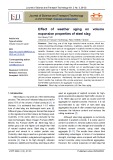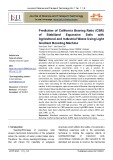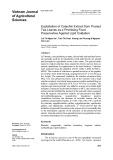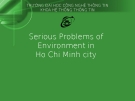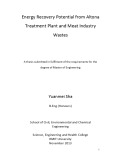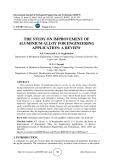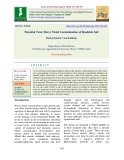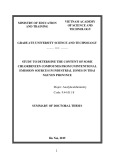
Industrial waste
-
Steel slag, one of the huge industrial waste sources, which has many outstanding advantages (hardness, roughness, angularity, and abrasion resistance) has been used as an aggregate in asphalt concrete to bring many benefits.
 7p
7p  viengfa
viengfa
 28-10-2024
28-10-2024
 3
3
 2
2
 Download
Download
-
Light Gradient Boosting Machine is a new machine learning technique developed by Microsoft corporation which has been proposed in the present study to determine the CBR of stabilized expansive soils. Model performance of the ML model are evaluated by different criteria such as correlation coefficient R, root mean square error RMSE and mean absolute error MAE.
 8p
8p  viengfa
viengfa
 28-10-2024
28-10-2024
 4
4
 2
2
 Download
Download
-
In Vietnam, a tea-producing country, the tea buds and top three leaves are normally used for tea production while older leaves are pruned and discarded as agricultural waste in the winter. The present study aimed to exploit catechins from pruned tea leaves and use them as natural antioxidants for applications in the food industry.
 12p
12p  vibecca
vibecca
 01-10-2024
01-10-2024
 4
4
 2
2
 Download
Download
-
Saigon river is also polluted by industrial and agricultural waste water from small-sized enterprises along the river which is to 65.000 cubic meters a day. Residential waste water another pollution factor. Everyday, 74.800 cubic meters of waste water in dumped into the river from residential in localities, with over 90% of the waste coming from Hồ Chí Minh city.
 62p
62p  tet0202
tet0202
 19-02-2013
19-02-2013
 45
45
 5
5
 Download
Download
-
The aim of this project is to provide a summary of the current knowledge on energy recovery options from wastewater treatment plants sludge and/or biosolids. This covers technologies as well as data from case studies and research experimental results. The focus of the study is the ATP. The project methodology comprised two stages. The first stage involved a review of the current literature.
 166p
166p  runthenight07
runthenight07
 01-03-2023
01-03-2023
 12
12
 3
3
 Download
Download
-
This paper presents a review on improvement of aluminium alloy for engineering application. The study shows that inclusion of agro industrial waste improved mechanical properties of the developed material.
 6p
6p  lucastanguyen
lucastanguyen
 01-06-2020
01-06-2020
 36
36
 2
2
 Download
Download
-
A series of blends consisting of Red mud(RM) varying from 1.5 to 3 g and Graphene oxide(GO) varying from 0 to 1.5 g to give a total of 3g were prepared.
 10p
10p  lucastanguyen
lucastanguyen
 01-06-2020
01-06-2020
 11
11
 3
3
 Download
Download
-
As the urban area has high population density and intensive anthropogenic activities, there are a great number of sources of heavy metals in cities, placing a considerable influence on human health. Emissions of heavy metals may come from domestic waste, chemical industry and transportation. These emissions have been continuously adding heavy metals to soils and they will remain present for many years even after the pollution sources have been removed.
 7p
7p  nguaconbaynhay5
nguaconbaynhay5
 16-05-2020
16-05-2020
 24
24
 0
0
 Download
Download
-
Research objectives of the thesis: Study the process of simultaneous determination and evaluation of the method of analyzing 7 chlorobenzene, including 1,2- 4 dichlorobenzene (1,2-DCB); 1,3-dichlorobenzene (1,3-DCB); 1,2,4- trichlorobenzene (1,2,4-TCB); 1,2,3,4-tetrachlorbenzene (1,2,3,4- TeCB), 1,2,4,5-tetraclobenzene (1,2,4,5-TeCB); pentaclobenzene (PeCB) and hexaclobenzene (HCB) in trace and superficial content in flue gas samples and industrial waste (fly ash, bottom ash, input materials).
 26p
26p  xacxuoc4321
xacxuoc4321
 08-07-2019
08-07-2019
 55
55
 9
9
 Download
Download
-
The earth’s surface is two-thirds water, yet most of this is undrinkable or unusable because it is either seawater or ice. Of the 1% that is available as fresh water, most is used for farming or industry. Fresh water pollution is the major problem because many rivers and streams are being polluted with pesticides, industrial waste, and sewage. In poor and developing countries, the addition of sewage to the sources of water leads to diseases, and even death. A United Nations’ report estimates that more than 78% of people drink from polluted water supplies.
 7p
7p  rrtrungrr11
rrtrungrr11
 27-03-2013
27-03-2013
 375
375
 23
23
 Download
Download
-
It is estimated that approximately one-third of the world’s population are using groundwater for drinking purposes. Pollution of ground water due to industrial effluents is a major issue (Vasanthavigar et al., 2011). Poor groundwater quality brings negative impact to human health and plant growth. In developing countries like India, it is estimated that around 80% of all diseases are directly related to poor drinking water quality and unhygienic conditions (Olajire & Imeokparia, 2001; Vasanthavigar et al., 2011).
 37p
37p  lulanphuong
lulanphuong
 28-03-2012
28-03-2012
 81
81
 14
14
 Download
Download
-
Landfill gas from a source of green energy, clean, renewable and can be used to create electricity, or used in the energy industry. This paper reviews the potential energy recovery landfill gas from municipal solid waste, to reducing methane emissions in particular, and reduced greenhouse gas emissions in general. In addition, this paper provides an assessment using the model of methane generated from landfill municipal solid waste and generate energy potential of gas recovered. In particular, this paper uses a life cycle assessment methods ......
 10p
10p  thulanh2
thulanh2
 07-09-2011
07-09-2011
 105
105
 18
18
 Download
Download
-
Pot and field trials were carried out using sediment dredged from the port of Bremen (Germany) and deposited in a settling basin near Bremen; the sediment is polluted with Cd and Zn. Five iron-bearing materials were added to the soil (1% pure Fe in soil dry matter) to immobilize the heavy metals: ‘Red mud from the aluminium industry, sludge from drinking-water treatment, bog iron ore, unused steel shot and steel shot waste.
 8p
8p  tudoia
tudoia
 06-04-2011
06-04-2011
 122
122
 7
7
 Download
Download
-
Waste generated for the during the red mud, an industrial ore, aqueous the byproduct, is recycled solution. such processing of were congo of bauxite red from adsorption kinetics Adsorption studied using dose, parameters time as dye concentration, Adsorption adsorption isotherms. dye was followed data The 4.05 adsorbent first rate both agitation The and red to and pH.
 17p
17p  tudoia
tudoia
 06-04-2011
06-04-2011
 105
105
 9
9
 Download
Download
-
Báo cáo này trình bày sản lượng khí sinh ra của quá trình phân hủy kỵ khí đối với nước rỉ rác và nước thải thủy sản ABSTRACT This report present about determining biogas quantity of anaerobic active slugged, researching with waste water from fishery industry, landfill.
 4p
4p  meoden89nd
meoden89nd
 21-01-2011
21-01-2011
 301
301
 76
76
 Download
Download
-
The global annual potential bioethanol production from the major crops, corn, barley, oat, rice, wheat, sorghum, and sugar cane, is estimated. To avoid con/icts between human food use and industrial use of crops, only the wasted crop, which is de0ned as crop lost in distribution, is considered as feedstock. Lignocellulosic biomass such as crop residues and sugar cane bagasse are included in feedstock for producing bioethanol as well. There are about 73:9 Tg ofdry wasted crops in the world that could potentially produce 49:1 GL year−1 ofbioethanol.
 15p
15p  nguyenngocsonctu
nguyenngocsonctu
 30-11-2010
30-11-2010
 137
137
 22
22
 Download
Download
CHỦ ĐỀ BẠN MUỐN TÌM









